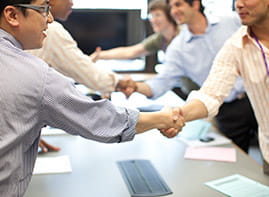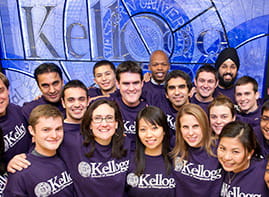How Agility Can Unlock Growth
At Kellogg’s 6th annual summit, marketing leaders share insights on building agile marketing organizations
By Theo Anderson10/21/2016 - The Kellogg School of Management’s annual Marketing Leadership Summit, held Sept. 14-15, brought together a full house audience of more than 100 senior marketing executives to discuss how agility is key to unlocking growth in their businesses and organizations.
“Agility is an urgent theme for marketing leaders,” said Eric Leininger, executive director of the Kellogg Chief Marketing Office Program. “Large companies want to learn to be more agile, and small companies that are scaling don’t want to lose their agility. The summit brought together a high-quality audience of marketing leaders who were really ready to engage with the speakers.”
“The conventional marketing approach of the “Big Campaign” and the “Big Plan” no longer works in the dynamic world of digital and social media,” said Mohan Sawhney, director of the Center for Research in Technology and Innovation at the Kellogg School. “Marketers need to embrace the agile mindset which involves ongoing customer engagement and rapid experimentation to adapt and improve your marketing initiatives.”
Kellogg hosts the summit in partnership with Egon Zehnder and McKinsey & Company. “They devote a tremendous amount of time and energy into producing leading-edge content and ensuring that we have engaging dialogue between industry and Kellogg,” Leininger said. Past summits have explored the future of marketing leadership and the role of cultural and disruptive technology in generating growth.
Buell Duncan, global vice president of portfolio marketing at IBM, noted in a panel discussion that “there’s never been a better time to be in marketing. And the reason there’s never been a better time is that marketing is leading the change” toward more agile corporate cultures.
Agility is “all about engagement with the customer,” Duncan said. “At the end of the day, marketing has to lead that thinking for the whole enterprise. Because it’s the tip of the arrow of how you engage the customer.”
Drawing on their own stories and experiences, speakers and panelists offered the participants four key insights for building more agile cultures and learning to navigate rapidly changing consumer markets.
Agility requires an understanding of your consumers’ passion points
Steve Fund, CMO of Intel Corporation, said, “Virtually everyone who uses a computer benefits from its technology, but its brand was losing relevance, especially among younger people. We didn’t fully understand their needs, what to say to them or how to engage them.”
Fund launched an integrated marketing campaign that helped the brand evolve that started with understanding the perspectives of young people —and making those perspectives central to the company’s marketing. Intel’s new campaign emphasized the ways that its products create “amazing experiences” in everyday life. It hired “lovable geek” Jim Parsons, a star of television’s highest-rated show, The Big Bang Theory as it’s brand spokesperson. Intel also began integrating it’s technology into sports broadcasting to create a better fan experience. The technology has been used during the Super Bowl, NBA’s All Star Game and Finals and MLB All Star Weekend.
The brand also partnered with the Grammy’s, XGames and Red Bull utilizing their technology in new and innovative ways. “For us, the best way to connect with young people is through their passion points; music, sports, entertainment and gaming. But it can’t just be this glued-on sponsorship. It has to be authentic.”
Take your core strengths to the next level in new, fast-paced environments
Like other media companies, The New York Times is navigating a steep drop in a major source of its revenue: advertising. “We’re pivoting an iconic, $2 billion-plus media company, while the rules of the business models are changing every single day,” said Sebastian Tomich, senior vice president of advertising and innovation.
The Times is answering the challenge by doing what it does best—telling stories—while experimenting with new forms.
“We believe that technology cannot disrupt what we do,” Tomich said. “We provide trust and we provide authority. If we can embrace technology rather than be afraid of it, then we can become that layer that sits on top of it.”
During the recent Summer Olympics in Brazil, the Times created high-quality visuals that offered unique perspectives on the action. “We didn’t need to surround the Olympics and be your go-to source of daily information,” Tomich said. “But what we thought we could do was provide some of the most in-depth visual analysis that allowed readers to think about these Olympians in a whole new way.”
The Times is also becoming more agile by experimenting with new ways to create personal connections between its writers and its audience. One of its reporters at the Olympics, for example, sent several text updates each day to people who signed up for the service. The writer, Sam Manchester, gave the texts an informal touch, using pictures and emojis to make them seem more personal and build a relationship with his audience.
Reimagining relationships outside and inside the company unlocks social agility
Until about two years ago, Wilson Sporting Goods relied on outside partners to manage its social media channels. The efforts were scattered, with different partners devoted to different sports, and the output was a one-way interaction, said Amy Weisenbach, vice president of marketing. “We weren’t having a conversation with consumers.”
Wilson has since brought its social media operations in-house and is creating a team that is devoted to it. “We wanted the content creation to sit closer to the heart of the business,” she said. “We’re still in the early stages, but we’re already testing and learning a lot of new things. It’s helping us use social for what it’s best at—being an enabler of conversations, and a connector to further engagement.”
In other words, for both Wilson and the Times, being agile means learning to use social-media content to build and broaden strong relationships with customers—and within the company. That agility and those relationships are synergistic, creating healthier corporate cultures.
When you want to move fast, perfect slows you down
GrubHub creates an agile culture by devoting 30 percent of its marketing efforts to launching ideas that the company has never tried before, and by valuing informed risk over certainty.
“Eighty percent readiness is good enough,” said CMO Barbara Martin Coppola. “You won’t get it perfect—so go and launch. In meetings, having a decision is really important. You have to empower your people to make a decision. And you have to trust them. Which means that there will be errors. There will be failures.”
What’s important, Martin Coppola said, are the takeaways from the process: “What are you going to do differently next time, to actually apply what you’ve learned?”
“The only failure is the failure to learn,” Sawhney said. “Redefine failure as an experiment.”
Gregory S. Carpenter, host of the summit and James Farley/ Booz Allen Hamilton Professor of Marketing at the Kellogg School, noted that the Market Leadership Summit was founded as a way to foster discussions about fundamental changes in marketing.
“The discussions about agility illustrate the value of such exchanges,” he said. “It’s wonderful to bring together more than 100 extraordinary people all focused on the same issue, all willing to share, and all eager to explore. Agility is an extraordinarily tough challenge for all firms. Hopefully, the summit provides added clarity and insight about the path toward greater agility. We certainly look forward to continuing the discussion and exploration of how marketing is changing and being a part of its future.”






